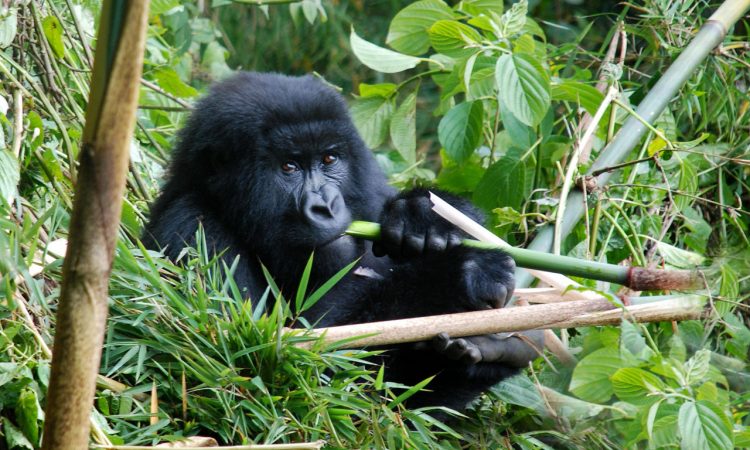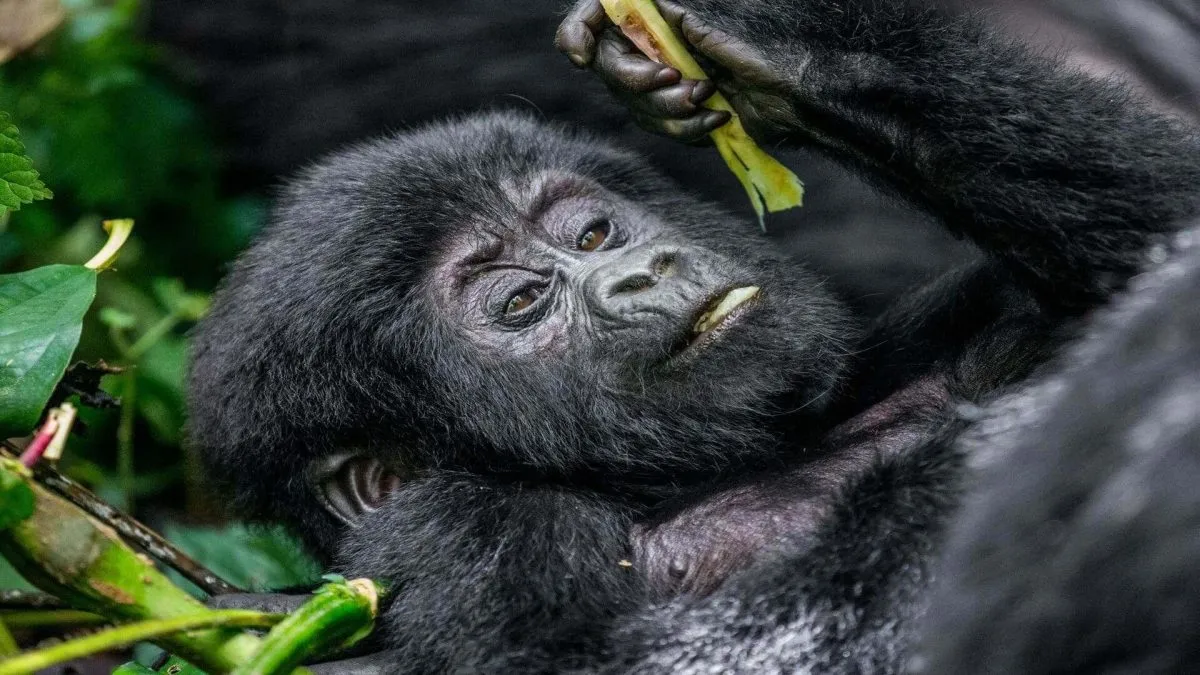Facts About The Gorilla Habituation Experience Permit In Uganda : The gorilla trekking adventure involves taking a group of researchers on an expedition into the forest and following a family of semi-habituated gorillas to acquaint them with humans without changing their natural ways.

As of now, Uganda is the best destination for Gorilla habituation experience. Two gorilla families in the southern sectors of Bwindi Impenetrable National Park are available for gorilla habituation. Additionally, the Rushaga and Nkuringo regions of Bwindi’s impenetrable national park are home to two locations for gorilla trekking.
WHAT IS THE GORILLA HABITUATION EXPERIENCE?
In the gorilla habituation experience, you embark on an expedition where you watch how a family of semi-habituated gorillas adjusts to human presence without changing who they are. You also get to go along with a group of researchers and acclimatizers. In order to be eligible for this activity, it would be ideal to have a valid gorilla habituation permit.
WHAT IS A GORILLA HABITUATION PERMIT?
The Ugandan wildlife administration issues a card known as a gorilla habituation permit, which enables individuals to assist in acclimating a semi-habituated gorilla family to human presence. Since gorilla habituation licenses are in high demand and are only issued to four families each day, it is advisable to obtain them in advance.
WHAT IS THE COST OF GORILLA HABITUATION PERMITS?
For foreign non-residents, gorilla habituation permits cost $1500 per person per trek; for foreign residents, they cost $1000; and for East African citizens, they cost 750000shs.
The cost of the gorilla habituation permit covers four hours with the mountain gorillas, a certificate upon completion of the experience, park entrance fees for the day, security, and support from the local community and gorilla conservation. The following items are not included in the price of the gorilla habituation permit: energy bits, packed lunches, porter fees, tipping, and much more.
IS THE GORILLA HABITUATION PERMIT REFUNDABLE?
Securing a gorilla habituation safari is akin to striking it lucky in the lottery, and forfeiting the ticket is equivalent to losing it. If you are eligible under the Uganda Wildlife Authority’s refund policy, you may request a refund of your gorilla habituation permit. Give the booking agency or Uganda Wildlife Authority sufficient notice if you anticipate being unable to attend the scheduled gorilla habituation session. If you are still eligible for a refund, you will be given instructions on what to do. Because money has to pass through bureaucracy in order to be reclaimed, patience is required.
CAN I RESCHEDULE THE GORILLA HABITAT PERMITS?
- It is permissible to reschedule the gorilla habituation permit, provided that you contact the Uganda Wildlife Authority.
- Requesting a rescheduling of your gorilla habituation permit to a prearranged date in writing to the Uganda Wildlife Authority.
- Your gorilla habituation permit is approved and then relocated to the chosen date, if there are any remaining openings.
- Uganda permits free gorilla habituation permits to be rescheduled twice for the same permit; however, the executive director must provide permission the third time. Furthermore, a 25% premium is added to the overall cost of the gorilla habituation permit.
HOW SAFE IS GORILLA HABITUATION ADVENTURE?
Gorilla habituation is safe, even though it’s like going on a Uganda safari in the wild. An armed ranger leader leads each gorilla acclimatization group, while another carries a machete to chop some creepers and clear paths as needed.
The security management of Bwindi Impenetrable National Park collaborates with other security agencies in Uganda to uphold law and order both inside and outside the park.
You need to be mindful of your own safety by avoiding street food that could upset your stomach. You might be barred from gorilla-habituating as a result of this.
Ask your driver’s guide for assistance if you would like to sample the local cuisine. The safest food points are known to the guide.
Enter the forest only when accompanied by a ranger guide. This is because there are wild animals in the forest that are not accustomed to seeing people and could pose a threat to you. Even in a place as big as Bwindi, to keep from getting lost.
WHAT HAPPENS DURING THE GORILLA HABITUATION ADVENTURE?
You pack your gorilla habituation kit, which includes sanitizer and at least two clean masks, and head to the ranger station early in the morning. The return time is unknown, so don’t forget to pack a packed lunch.
Along with a group of researchers, the park warden and ranger will walk you through the guidelines and procedures of gorilla habituation. You stop along the route to rest and refuel if needed, but you don’t want to leave the forest littered.
With a group of researchers and a sense of familiarity, you clean your safari boots and follow the trail to the location where the mountain gorillas were last observed. The mountain gorillas might be just leaving their nesting place or starting to prepare breakfast when you locate them.
WHAT DO YOU DO WHEN YOU LOCATE THE MOUNTAIN GORILLAS?
The attitude surrounding the mountain gorillas must be established by the researchers and rangers before they approach them. The mountain gorillas in the wild are vulnerable to outsiders. If there is a fight among the gorilla family, you won’t be able to see them until the conflict has subsided.
You are expected to follow the guidelines of gorilla habituation by taking notes, paying attention, and attempting to interact with the mountain gorillas during your time with them. You must be loyal to the dominant silverback in order to avoid coming across as suspicious, as he occasionally likes to flaunt his majestic authority over the gorilla family.
It is normal for gorillas to hide from humans, so be prepared for this. They are still getting acclimated to our presence. When this occurs, heed the researchers’ instructions and rely on habituation; by this point, they might have developed a response. Make sure you only push your way to the areas where the gorillas have withdrawn for safety.
Try to maintain a distance of roughly 8 meters from the mountain gorillas as a rule to avoid gorilla habituation. They retreat covertly as they get closer. Take pictures during the hours of habituation so you have them for future reference.
You get four hours to spend with the mountain gorillas until they progressively leave to let you return to your lodge and unwind.
HOW DANGEROUS ARE MOUNTAIN GORILLAS DURING HABITUATION?
The mountain gorillas are not aggressive during this experience, despite becoming somewhat acclimated. In contrast, despite their intimidating stature and physique, mountain gorillas are calm and reserved.
Avert staring into the mountain gorillas’ dark, sunken eyes since this could make them see you with suspicion. The family members may be ordered to flee into the deeper forest ends by the silverback if he notices something strange about the outsiders.
Steer clear of inciting the mountain gorillas, as this could lead to a stampede or fury in the jungle.
The mountain gorillas can do a lot of things when they’re upset, such as pull grass around them, thump their chests loudly, walk on one foot, and hoot.
In the history of gorilla habituation, no tourist has ever been a victim of a mountain gorilla attack.

WHAT IS THE HISTORY OF THE GORILLA HABITUATION ADVENTURE?
In 2014, the Uganda Wildlife Authority initiated a gorilla acclimatization program, and the rest is history. As a result, visitors were able to spend more time with the mountain gorillas and experience a sense of pride in having been a part of the gorilla trekking family. Gorilla habituation provides you with extra time, even though you can still go gorilla trekking more than once. A group of tourists gets the chance to accompany a group of researchers as they spend four hours observing and recording information about the mountain gorillas.
HOW LONG IS THE GORILLA HABITUATION ADVENTURE?
The duration of gorilla habituation varies depending on the conditions in the forest. Depending on where they may spend the day, you may occasionally find the mountain gorillas two hours or more after the walk begins.
The gorillas may go into hiding to avoid conflict with other gorilla families or with family members, which would make it more difficult to find them.
For a while, mountain gorillas only ate in one place. When their food supply runs out, they relocate; however, it could take some time to determine where the habituated gorilla family has gone.
It matters even how quickly humans become habituated to gorillas. The gorilla takes longer to get habituated while moving extremely slowly.
Your progress through the forest may be hindered by slick pathways and damp ground during the intensely rainy seasons.
With all of this, you experience a mixture of intense thrills and anxiety when you first see the mountain gorillas. It could be necessary for you to recall all that happened to you prior to finding the mountain gorillas.
Since mountain gorillas are wild primates going about their daily lives, a certain amount of patience is required for gorilla habituation.
IS GORILLA HABITUATION DIFFICULT?
Because the Virunga region is primarily volcanic in topography, hiking over several ridges and plateaus may be necessary to reach the mountain gorilla’s daytime habitat. If you are physically incapable, you must either hire a sedan chair or maintain a certain level of fitness.
Wearing the appropriate safari boots that can handle muddy terrain and slick hills will help you survive a gorilla habituation experience. You can also ask for a walking stick to provide you with additional support while you seek out the mountain gorillas.
Just before you set out on your expedition, you can hire a porter to carry your gorilla training equipment. You may walk about freely and get the finest images with the least amount of interruption when you do this.
WHAT ARE THE DOS AND DONOTS OF GORILLA HABITUATION ADVENTURE?
- It is prohibited to dump trash in the wilderness because it changes the ecosystem of the forest, which serves as a food source for mountain gorillas, especially non-biodegradable trash like plastic wrap.
- It is improper to urinate on the ground or in plants since these taints the food that the mountain gorillas eat.
- When you find the mountain gorillas, stay around 8 meters away from them. They are quite vulnerable to infections from humans.
- Due to the nature of the forest, gorilla habitat is only available to those who are at least 15 years old. A child younger than this might not be able to endure the lengthy gorilla habituation sessions. A youngster can find it difficult to tolerate the wetness of the ground even there.
- If you want to eat or drink, stay at least 200 meters away from the mountain gorillas. This will stop them from stealing human food. Being untamed creatures, they have to look for food on their own.
- You only get four hours to see the mountain gorillas once you find them before letting them go about their daily lives.
- In order to avoid infecting the extremely vulnerable mountain gorillas, COVID-19 volunteers stay behind when they have a contagious illness, such as a cough.
- Because mountain gorillas are vulnerable to strangers, it is forbidden to provoke them.
- In order to avoid frightening the mountain gorillas during their habituated period, never use flash photography.
- During the gorilla habituation period, stick together as a group; otherwise, the mountain gorillas can feel assaulted.
- Prior to visiting mountain gorillas, put on a mask—a precaution implemented in the wake of the COVID-19 outbreak.


